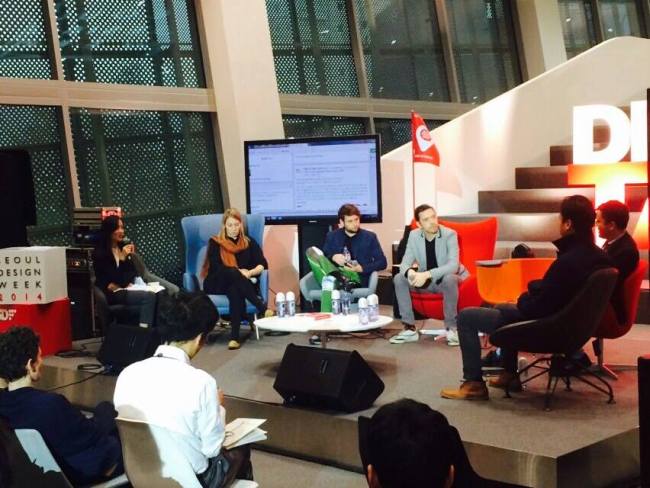When Paul Cocksedge, a London-based light designer, entered Dongdaemun Design Plaza, a futuristic Seoul landmark designed by Iraqi-British architect Zaha Hadid, he was in awe of the unusual architecture and its spaciousness.
“This building feels really healthy with lots of walking,” said the designer on Friday during the Design Talk, part of Seoul Design Week, which was held from Nov. 26-30.
Five designers talked about three topics: the DDP, Korea’s design content and the Seoul Design Spot Tour. They had toured Seoul’s trendiest streets, workshops and showrooms, which opened their doors to the public during the five-day event.
“But I see performances, I hear music and live with activities in these open spaces,” he said. “By opening up the building to performers, not only to designers, it will inspire more people.”
He cited the Curve Gallery at the Barbican Centre in London, initially an in-between space with no natural lights but now utilized as an exhibition space for experimental arts.
“This building feels really healthy with lots of walking,” said the designer on Friday during the Design Talk, part of Seoul Design Week, which was held from Nov. 26-30.
Five designers talked about three topics: the DDP, Korea’s design content and the Seoul Design Spot Tour. They had toured Seoul’s trendiest streets, workshops and showrooms, which opened their doors to the public during the five-day event.
“But I see performances, I hear music and live with activities in these open spaces,” he said. “By opening up the building to performers, not only to designers, it will inspire more people.”
He cited the Curve Gallery at the Barbican Centre in London, initially an in-between space with no natural lights but now utilized as an exhibition space for experimental arts.

Lee Seong-yong, a Korean designer at Pearson Lloyd, a multidisciplinary design studio in London, noted the lack of content and the need for a guide system: “Eventually the content will be filled, but the building should become friendlier and more open because people can easily feel intimidated and out of place here.”
“The amount of ground this building covers is amazing,” said Robert Le Quesne, creative director of London-based marketing and technology company H-ART. He said that if the Korean government had intended to transform the city into a design and cultural hub, “it doesn’t (have to) get bigger than this building. It is about how to grow beyond the building.”
Le Quesne added that he found Seoul incredibly refreshing and playful, a place where old and new are fused into something unique and contemporary.
How can the city go beyond the building and evolve into a design-friendly city?
Jules van den Langenberg, a designer from the Netherlands, noted that the Design Week is a good starting point for dialogue between different parties, including the government, designers and the public.
“Creating a platform for young local designers is critical to building the identity of Korean design,” said Michou-Nanon de Brujin, a senior designer at Studio Makkink & Bey in the Netherlands. “(It should be) a platform where young people can share their works and be proud of each other’s work.”
“If I get a chance in the future, I would like to participate in the mapping project of the city, finding effective ways to connect and perceive the city,” Le Quesne said, adding he had difficulties finding his way around the city.
Langenberg said that while walking around Seoul on a design tour, he found it more interesting to observe craftsmen in their natural habitat. “They were more relaxed,” he said.
The 90-minute session was attended by about 100 experts and students.
“The talk was very informative and it was interesting to hear ideas from people with different backgrounds and perspectives,” said Dan Howarth, a journalist with the architecture and design magazine Dezeen in London.
Seoul Design Week was co-organized by the Seoul Design Foundation, Herald Corp. and Design House.
By Ahn Sung-mi (sahn@heraldcorp.com)
-
Articles by Korea Herald




![[Herald Interview] 'Amid aging population, Korea to invite more young professionals from overseas'](http://res.heraldm.com/phpwas/restmb_idxmake.php?idx=644&simg=/content/image/2024/04/24/20240424050844_0.jpg&u=20240424200058)












![[KH Explains] Korean shipbuilding stocks rally: Real growth or bubble?](http://res.heraldm.com/phpwas/restmb_idxmake.php?idx=652&simg=/content/image/2024/04/25/20240425050656_0.jpg&u=)

